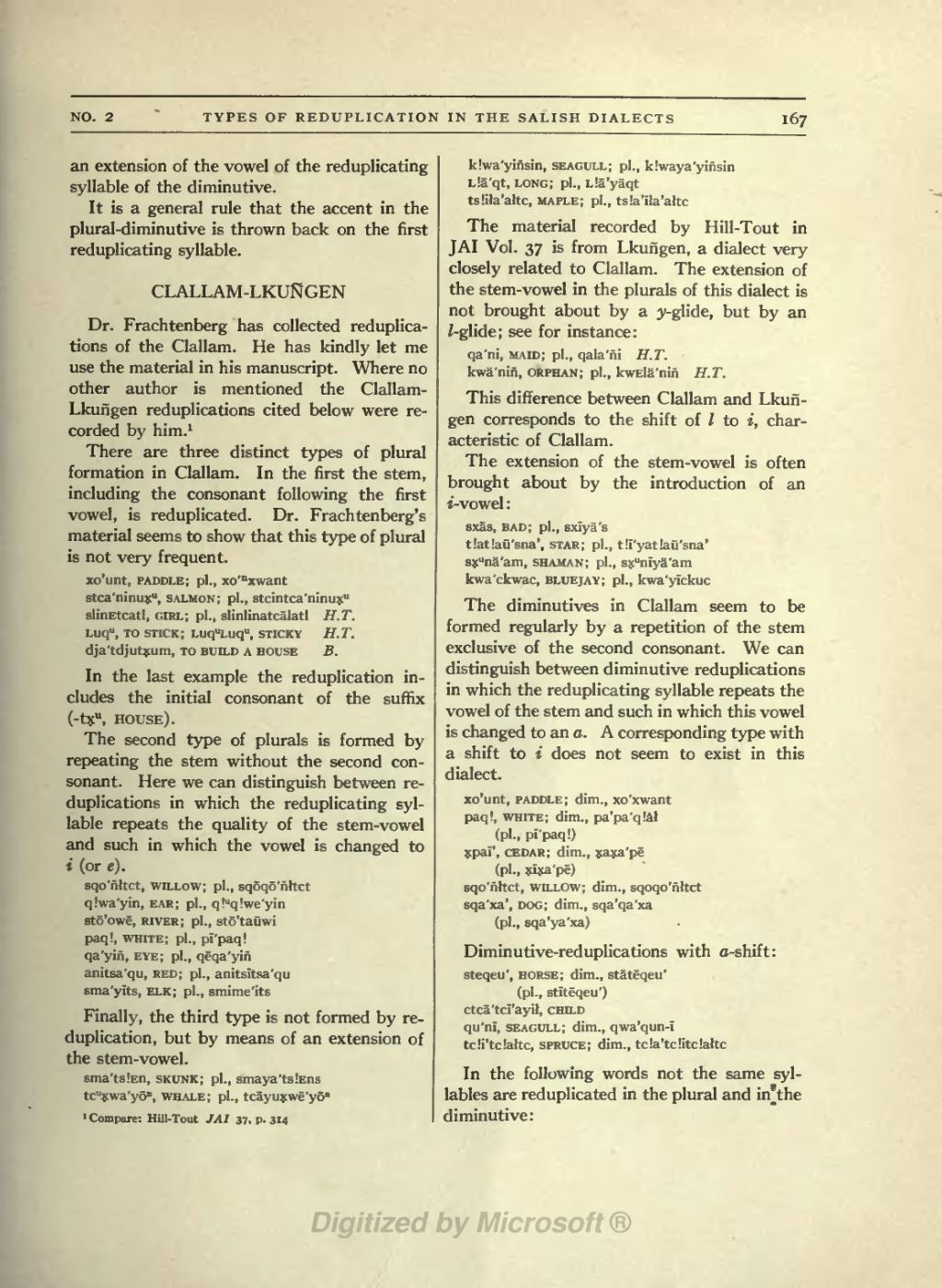NO. 2
��TYPES OF REDUPLICATION IN THE SALISH DIALECTS
��I6 7
��an extension of the vowel of the reduplicating syllable of the diminutive.
It is a general rule that the accent in the plural-diminutive is thrown back on the first reduplicating syllable.
CLALLAM-LKUNGEN
Dr. Frachtenberg has collected reduplica- tions of the Clallam. He has kindly let me use the material in his manuscript. Where no other author is mentioned the Clallam- Lkungen reduplications cited below were re- corded by him. 1
There are three distinct types of plural formation in Clallam. In the first the stem, including the consonant following the first vowel, is reduplicated. Dr. Frachtenberg's material seems to show that this type of plural is not very frequent.
xo'unt, PADDLE; pi., xo' n xwant
stca'ninux", SALMON; pi., stcintca'ninux"
slinEtcatl, GIRL; pi., slinlinatcalatl H.T.
Luq u , TO STICK; Luq"Luq u , STICKY H.T.
dja'tdjutxum, TO BUILD A HOUSE B.
In the last example the reduplication in- cludes the initial consonant of the suffix (-tx u , HOUSE).
The second type of plurals is formed by repeating the stem without the second con- sonant. Here we can distinguish between re- duplications in which the reduplicating syl- lable repeats the quality of the stem-vowel and such in which the vowel is changed to i (or e).
sqo'nltct, WILLOW; pi., sqoqo'nhct
qlwa'yin, EAR; pi., q! u q!we'yin
sto'owe, RIVER; pi., sto'tauwi
paq!, WHITE; pi., pi'paq!
qa'yin, EYE; pi., qeqa'yin
anitsa'qu, RED; pi., anitsitsa'qu
sma'yits, ELK; pi., smime'its
Finally, the third type is not formed by re- duplication, but by means of an extension of the stem-vowel.
sma'tslEn, SKUNK; pi., smaya'tstens tc u xwa'yo, WHALE; pi., tcayuxwe'yo" 'Compare: Hill-Tout JA1 37, p. 314
��khva'yinsin, SEAGULL; pi., khvaya'yinsin Lla'qt, LONG; pi., Lla'yaqt tslila'aftc, MAPLE; pi., ts!a'iJa'a}tc
The material recorded by Hill-Tout in JAI Vol. 37 is from Lkungen, a dialect very closely related to Clallam. The extension of the stem-vowel in the plurals of this dialect is not brought about by a y-glide, but by an /-glide; see for instance:
qa'ni, MAID; pi., qala'ni H.T.
kwa'nin, ORPHAN; pi., kwEla'nin H.T.
This difference between Clallam and Lkun- gen corresponds to the shift of / to i, char- acteristic of Clallam.
The extension of the stem-vowel is often brought about by the introduction of an t-vowel :
sxas, BAD; pi., sxlya's
t.'at.'au'sna', STAR; pi., t!i'yat!au'sna'
sx u na'am, SHAMAN; pi., sx u mya'am
kwa'ckwac, BLUEJAY; pi., kwa'yickuc
The diminutives in Clallam seem to be formed regularly by a repetition of the stem exclusive of the second consonant. We can distinguish between diminutive reduplications in which the reduplicating syllable repeats the vowel of the stem and such in which this vowel is changed to an a. A corresponding type with a shift to i does not seem to exist in this dialect.
xo'unt, PADDLE; dim., xo'xwant paq!, WHITE; dim., pa'pa'q.'al
(pi., pi'paq!) xpal', CEDAR; dim., xaxa'pe
(pi., xlxa'pe)
sqo'nltct, WILLOW; dim., sqoqo'nltct sqa'xa', DOG; dim., sqa'qa'xa
(pi., sqa'ya'xa)
Diminutive-reduplications with c-shift: steqeu', HORSE; dim., stateqeu'
(pi., stiteqeu') ctca'tci'ayil, CHILD qu'ni, SEAGULL; dim., qwa'qun-I tcli'tcJaftc, SPRUCE; dim., tc!a'tc!itc!altc
In the following words not the same syl- lables are reduplicated in the plural and in[the diminutive :
�� �
